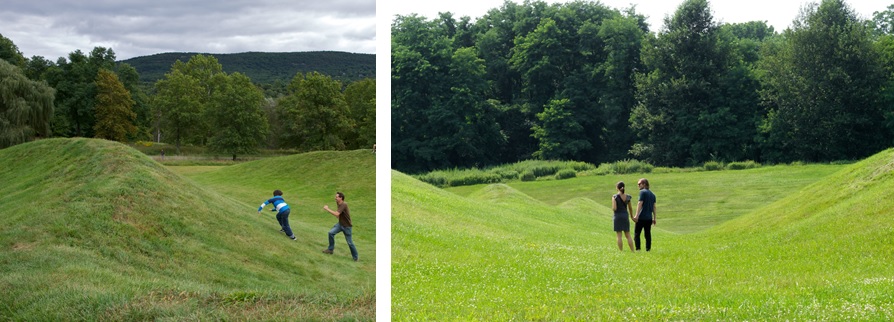Storm King Wavefield Conservation
VISITOR COOPERATION AND TWO-WEEK REST PERIODS
Storm King Wavefield is a living, evolving earthwork. Native grasses planted across the rolling waves prevent erosion and soil compactions. The care of these grasses is essential to maintaining the artwork.
In recent years, weather conditions and increased foot traffic on Storm King Wavefield have damaged these grasses, threatening the form and structural stability of the artwork. We are launching this conservation effort to ensure Storm King Wavefield’s health and stability far into the future.
Entry to Storm King Wavefield is allowed from the 15th through the end of each month, beginning June 15 through December 31. Weather and ground conditions may occasionally restrict access during this period. Entry is not allowed from the 1st through the 14th of each month.
“I think with living sculptures, it doesn’t even end. Your job doesn’t end. The other half of making the work begins once you’ve finished sculpting it.” – Maya Lin, Storm King Oral History Project, 2018
Storm King Wavefield Conservation FAQ
Why can't I enter Storm King Wavefield before June 15?
The soil is most susceptible to compaction and damage from January – June, when the ground is fully or partially frozen in winter, and during the rainy spring months. Preventing foot traffic during this time is essential for the resilience of the grasses in subsequent months.
Why the two-week rest periods?
Periods of rest allow Storm King Wavefield’s living environment to remain resilient by limiting erosion and soil compaction from foot traffic.
What is soil compaction?
Soil compaction happens when soil is compressed, making it hard and dense. In the case of Storm King Wavefield, this happens when the same area is walked on repeatedly. Compacted soil can’t hold much water, air, or nutrients—this makes it difficult for most worms, bugs, and plants to survive. Weeds, which have long, tough roots, tend to thrive in compacted soil and can push out native species.
Without the roots of the native grasses helping to hold the soil in place, the tops of the ridges of Wavefield can be easily eroded by rain and foot traffic, changing the shape of the artwork.
What weather and ground conditions will occasionally restrict access?
Soil moisture levels are a good indicator of how much damage will be done by foot traffic: the more soil moisture, the greater the damage. You can expect Storm King Wavefield to be closed to visitor interaction during and soon after rainfall.
What has happened to the work to damage it or affect its structural integrity? Can I see this damage?
As mentioned above, damage to the native grasses on Storm King Wavefield has changed the shape and structural integrity of the artwork. You can see some areas of damage, evident in the lack of and discoloration of grass. You can also see how the ridges (the peaks or crests of the waves) have flattened. Visitors walking across the ridges has flattened them and created footpaths.
What does the artist recommend?
Maya Lin discussed visitor interaction with Storm King Wavefield in a 2018 interview for Storm King’s Oral History Project.
About walking across the ridges:
“Everybody likes to walk just along the ridge. And as long as they walk transverse to the waves, it’s fine. But, of course, that requires a little bit of extra effort on your part to go up and down, so everyone just cheats and says, ‘I’m going to climb to the ridge,’ and that kills the ridge. It just—it cannot take that kind of cowpath going along.”
About immersing yourself in the valleys:
“What if I could pull these waves up over your head so that you’re actually lost within a wave flow? To me, these works, and maybe all my works, tend to try to dialogue with you on a very empathetic, physical, physiological level so that it’s literally ‘forget about anything you might know or want to connect to and just be within it and kind of connect one-on-one to the piece.’”
How can I view and interact with Storm King Wavefield?

Use your body. When open to visitor interaction, walk up and over the waves. Are they steeper than you imagined? Are they higher than you imagined?
Listen to your surroundings. When open to visitor interaction, immerse yourself in a valley, with wave ridges on either side of you. What is this experience like? What do you see? What do you hear? How is this way of experiencing the work different from climbing up and over a ridge? How are those sights and sounds different? If you are visiting with another person, stand in the valleys on either side of the same ridge. Try talking. Can you hear each other over the waves?
Experience from above. At the overlook (accessible via the path near the south pond), close your eyes for 30-45 seconds. What do you hear? Now open your eyes and look out at Storm King Wavefield. What do you observe about the artwork? How does it fit in with the natural surroundings? How did the journey up to this vantage point inform how you think about the work?
Look into the valleys. Approach Storm King Wavefield from the southern end of the south pond. Close your eyes for 30-45 seconds. What do you hear? Open your eyes and look out at Storm King Wavefield. What do you observe about the artwork? Compare and contrast this perspective of the work with that from above.
Draw. Sketching is a great way to engage in close looking. No paper or pencil? No problem! Use your finger to trace the contours of Storm King Wavefield in the air. Compare and contrast the contours from different perspectives.